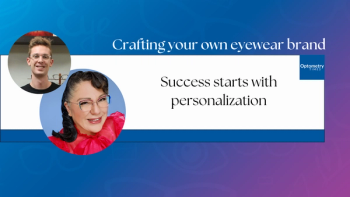
- September/October digital edition 2025
- Volume 17
- Issue 05
What a pharmaceutical representative taught me about glaucoma drops
Locking in correct prescriptions is as easy as checking a box.
Believe it or not, I was the starting quarterback on my high school football team. I can feel you laughing—stop that. I was pretty fast and could throw the ole pigskin decently. However, if I got hit, I was 100% going down. There were few to no yards after contact, and if a handoff counted as a complete pass, I’m sure I would have held several state records.
I digress. High school football was tough, but it was fun. That’s likely because we had a coach who was, well, tough and fun. I learned much about life from him. One thing that really stuck with me, however, was when he said, “You’re never as good as you think you are, but you’re never as bad as you think you are, either.” Misplace a few clauses in that statement and you’ve got some straight-up Yoda-isms right there. My coach also told us never to stop learning, and I’ve managed to keep that mantra with varying degrees of success over the years. Self-deprecating columns aside, I’ve tried to learn from what I’ve done right and even more so from what I’ve done wrong. As I sat down to write this month’s column, I was reminded of something I learned in the arena of glaucoma that really blew my mind, and I learned it from a pharmaceutical representative.
It was a busy Wednesday in the clinic, as most Wednesdays are. I was a few patients deep when 2 glaucoma representatives came in. Feeling pressed for time, I do admit that I took a deep, sighing breath before coming up front and greeting them with a smile and a polite “hello.” We briefly chatted, and they asked me about how I prescribe glaucoma drops. I replied that I e-prescribed them, and they asked me to show them. So, I politely and briefly showed them how I had a prostaglandin analogue (which happened to be the one owned by their company) prepopulated in a queue with a large bottle and 2 refills. Failing to see the point, I asked why I was showing them this. They replied with a question of their own: Do you always click on the dispense as written/do not substitute box? At the time, I didn’t think I needed to. Here was a prescription for a specific prostaglandin analogue molecule at a specific concentration—enough said, right?
Then I got schooled. I was informed of something that I did not know at the time. Pharmacies could switch medications within the same drug class, even to different concentrations or different molecules. That irked me a good bit.
Now, you’re likely thinking that Dr Ben has gone the way of industry and written an advertorial for Big Pharma, and I’m here to say that you are a bit premature in your judgment. I’m also not writing some idealistic column about fictitious patients for whom I’m able to get the most expensive branded medications. Indeed, 70% of my patient population still relies on Medicaid for their health insurance. I am somewhat constricted with respect to what I can prescribe that will be attainable for my patients. With that in mind, let me tell you what my favorite prostaglandin analogue is: It’s whatever I have a sample of at the time. A 2.5-mL sample is approximately 1 month’s worth of medication, which is typically the time frame I give said medication to get its full effect. If the target IOP is not attained, I will typically exhaust several prostaglandin analogues, if attainable, before switching classes. Over the years, this approach has really driven home to me that not all prostaglandin analogues work the same in all patients. Truly, glaucoma is not cookie-cutter, and the glaucoma specialist who tells you that the same generic prostaglandin analogue works just as well as branded medications in all patients with glaucoma is incorrect.
So, if I have arrived at a medication that is attainable, tolerable, and sufficiently efficacious for a patient, then that’s the medication I want that patient to take, and I need to go the extra step to ensure that the patient’s medication is not being switched at the pharmacy. There is a reason I have arrived at a particular glaucoma medication—or recommendation for laser, minimally invasive glaucoma surgery, or cataract surgery, for that matter. With that said, I will admit that most of my patients end up on a generic prostaglandin analogue for financial reasons, but there are branded medications that find their way onto Medicaid formularies with desirable co-payments. I don’t know everything that goes on in the back end to make that happen, and I really don’t care. I’m just glad to have options for the patients I serve.
Now, as for steroid drops, don’t even get me started.
Articles in this issue
about 1 month ago
So you want to create a private label eyewear brand?about 1 month ago
Study establishes reference data set for GA lesion progressionabout 2 months ago
AI glasses fill in gaps for patients with low visionabout 2 months ago
Top-line DEWS III updatesNewsletter
Want more insights like this? Subscribe to Optometry Times and get clinical pearls and practice tips delivered straight to your inbox.
















































.png)


